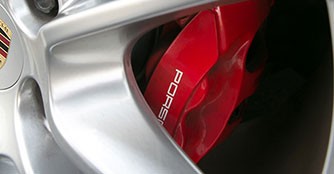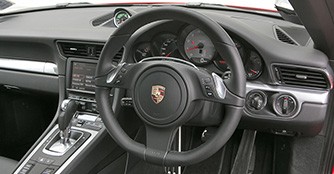Porsche 911 Carrera S 3.8 PDK (A) Review
04 Mar 2013|15,810 views
One never forgets the first time… First kiss, first pay cheque, first love and, yes, the first 911. The year was 1989. I was 17 so you can imagine the excitement I felt when my uncle whom I was living with in California came home with a silver 1974 911E. When I finally got a chance to get behind the wheel, I was thrilled and overwhelmed with joy, to say the least.
Funny thing was the acceleration didn't feel as addictive as the 300ZX that was parked next to it in the garage. Plus, the exhaust note was kind of whinny and I didn't pull in any chicks with it.
It was, unfortunately, disappointing. I told myself it was one of those situations where the car wasn't old enough to be a classic and too old to be a state-of-art.
Back in the present, and climbing into the 911 Carrera S, I realised a lot has changed in the last 20 odd years or so. Yet much has remained the same…
Exterior
The current incarnation of the 911 (model code 991) doesn't look very different from the car it replaces (model code 997). It is not actually saying much as the 911's shape and silhouette is probably one of the most recognisable in the world. The basic shape of this seventh generation 911 is the same but it's somehow more diluted from the original.
Funny thing was the acceleration didn't feel as addictive as the 300ZX that was parked next to it in the garage. Plus, the exhaust note was kind of whinny and I didn't pull in any chicks with it.
It was, unfortunately, disappointing. I told myself it was one of those situations where the car wasn't old enough to be a classic and too old to be a state-of-art.
Back in the present, and climbing into the 911 Carrera S, I realised a lot has changed in the last 20 odd years or so. Yet much has remained the same…
Exterior
The current incarnation of the 911 (model code 991) doesn't look very different from the car it replaces (model code 997). It is not actually saying much as the 911's shape and silhouette is probably one of the most recognisable in the world. The basic shape of this seventh generation 911 is the same but it's somehow more diluted from the original.
 |
The front fender peaks are less prominent, windscreen more raked and the headlamps appear to be spaced wider apart. At the rear, the slim LED tail lamps together with the stretch rear three quarter make the rump appear bigger yet give the car a more modern look.
Yes, the 991 looks fresher than the 997 and, nostalgia aside, it is a better looking car. And with the aluminium content of the bodyshell now at 45 percent, the Carrera S is actually lighter than its predecessor by 40kg despite being bigger.
The spindly 9-spoked alloys are a far cry from the legacy Fuchs-design but do a good job of showing off the brakes and making the car look less 'heavy'.
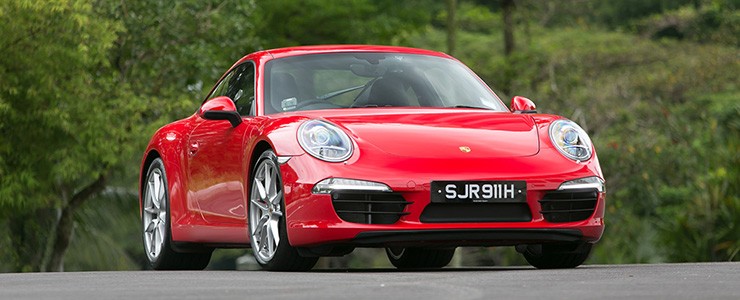 |
Interior
No surprises here as the tachometer in the binnacle are flanked by two smaller dials on each side. Useful information like oil temperature and gimmicky ones like G-forces are available at a glance but everything is legible and doesn't appear cluttered.
There's this sense of simplicity the 911 cabin exudes. The buttons for the various functions are all laid out logically on the centre console and have a singular purpose.
One doesn't need to delve into menu after menu to effect the damper settings or switch off traction control. And the seats which never looked like much are surprisingly supportive and yet comfortable.
Maybe its tradition, but one still needs to insert the key into the ignition to fire up the car. What's wrong with having a start button?
No surprises here as the tachometer in the binnacle are flanked by two smaller dials on each side. Useful information like oil temperature and gimmicky ones like G-forces are available at a glance but everything is legible and doesn't appear cluttered.
There's this sense of simplicity the 911 cabin exudes. The buttons for the various functions are all laid out logically on the centre console and have a singular purpose.
One doesn't need to delve into menu after menu to effect the damper settings or switch off traction control. And the seats which never looked like much are surprisingly supportive and yet comfortable.
Maybe its tradition, but one still needs to insert the key into the ignition to fire up the car. What's wrong with having a start button?
The Drive
Once fired up, any complaints one might have disappear. With a maximum output of 400bhp from a 3.8-litre flat six, performance is said to be equal to the previous generation GT3.
Driven normally, the car is no different than a regular family sedan. Shifts are smooth while the ride is a tad firm but perfectly acceptable on our roads. There's also a bit more engine noise than what you'll experience in a normal car but wind/road noise insulation is top notch.
So yes, I was getting that deja-vu feeling of being disappointed. That was until the photoshoot was done and I got a chance to depress the Sport Plus button and give the engine a chance to stretch its lungs.
Once fired up, any complaints one might have disappear. With a maximum output of 400bhp from a 3.8-litre flat six, performance is said to be equal to the previous generation GT3.
Driven normally, the car is no different than a regular family sedan. Shifts are smooth while the ride is a tad firm but perfectly acceptable on our roads. There's also a bit more engine noise than what you'll experience in a normal car but wind/road noise insulation is top notch.
So yes, I was getting that deja-vu feeling of being disappointed. That was until the photoshoot was done and I got a chance to depress the Sport Plus button and give the engine a chance to stretch its lungs.
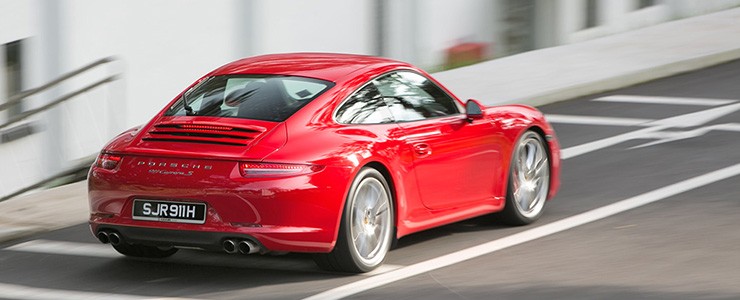 |
We've never been a fan of all these so-called sport buttons but in the Carrera S, it really transforms the character of the car. Not only is the ride noticeably firmer (the dampers do not just simply harden but they extensively firm up as compared to driving in normal mode), the throttle response is also sharper.
The exhaust note is absolutely addictive in this mode, too. It pops and crackles and while it's very different from the original's air cooled whine that purists rave about, it's still a very unique soundtrack.
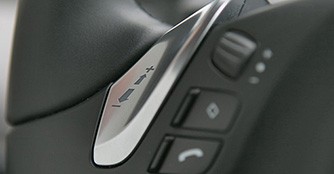
 Although not the most intuitive in its class, you can enjoy manual driving mode for a more enthusiastic drive
Although not the most intuitive in its class, you can enjoy manual driving mode for a more enthusiastic drive
Needless to say, don't believe what the 911 old timers say when they tell you to watch out for the 'pendulum effect' or about the polar moment of inertia. On public roads and with a sane mind, its unlikely that you'll breach the Carrera S' high limits.
There's just so much power on tap that speeding is more of a 'hit' than need. Plus, the electric power steering - devoid of having to transmit power and steer - is much more communicative than 90 percent of cars most Singaporeans will sample in their lifetimes.
It may not be able to compare with the unassisted steering of 911s of a bygone era but it jiggles less and it isn't as tiring to pilot on those trips up to Sepang for track days.
The exhaust note is absolutely addictive in this mode, too. It pops and crackles and while it's very different from the original's air cooled whine that purists rave about, it's still a very unique soundtrack.

Needless to say, don't believe what the 911 old timers say when they tell you to watch out for the 'pendulum effect' or about the polar moment of inertia. On public roads and with a sane mind, its unlikely that you'll breach the Carrera S' high limits.
There's just so much power on tap that speeding is more of a 'hit' than need. Plus, the electric power steering - devoid of having to transmit power and steer - is much more communicative than 90 percent of cars most Singaporeans will sample in their lifetimes.
It may not be able to compare with the unassisted steering of 911s of a bygone era but it jiggles less and it isn't as tiring to pilot on those trips up to Sepang for track days.
Speaking of track days, our red test car was equipped with Porsche's PDCC active roll control. But honestly, with the already excellent body control of the standard car, the feature isn't exactly necessary.
Conclusion
There's a seven-speed manual gearbox option and I believe nobody has ordered one on our shores yet. That's not saying the PDK double clutch gearbox is perfect but it's just a reflection of the times we live in. Everybody wants their cake and to eat it too.
The Carrera S is a good example of the everyday sports car. It's fast enough when driven in anger (with Sport Plus) yet docile enough for your girlfriend or wife to drive to the supermarket without worrying about ground clearance. Perhaps only through rose-tinted glasses will one really miss the 911s of yore.
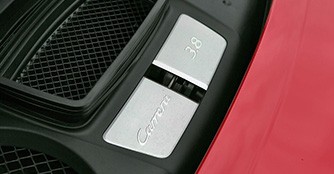
 The 3.8-litre powerplant has 440Nm of torque - more than sufficient to see to your daily short sprints around town
The 3.8-litre powerplant has 440Nm of torque - more than sufficient to see to your daily short sprints around town
But like the old 911s, the Carrera S can be underwhelming on first date, especially if placed on the pedestal of boyhood dreams. Its true strength is in the depth of its capabilities and enduring allure that comes with familiarity…
Conclusion
There's a seven-speed manual gearbox option and I believe nobody has ordered one on our shores yet. That's not saying the PDK double clutch gearbox is perfect but it's just a reflection of the times we live in. Everybody wants their cake and to eat it too.
The Carrera S is a good example of the everyday sports car. It's fast enough when driven in anger (with Sport Plus) yet docile enough for your girlfriend or wife to drive to the supermarket without worrying about ground clearance. Perhaps only through rose-tinted glasses will one really miss the 911s of yore.

But like the old 911s, the Carrera S can be underwhelming on first date, especially if placed on the pedestal of boyhood dreams. Its true strength is in the depth of its capabilities and enduring allure that comes with familiarity…
One never forgets the first time… First kiss, first pay cheque, first love and, yes, the first 911. The year was 1989. I was 17 so you can imagine the excitement I felt when my uncle whom I was living with in California came home with a silver 1974 911E. When I finally got a chance to get behind the wheel, I was thrilled and overwhelmed with joy, to say the least.
Funny thing was the acceleration didn't feel as addictive as the 300ZX that was parked next to it in the garage. Plus, the exhaust note was kind of whinny and I didn't pull in any chicks with it.
It was, unfortunately, disappointing. I told myself it was one of those situations where the car wasn't old enough to be a classic and too old to be a state-of-art.
Back in the present, and climbing into the 911 Carrera S, I realised a lot has changed in the last 20 odd years or so. Yet much has remained the same…Exterior
The current incarnation of the 911 (model code 991) doesn't look very different from the car it replaces (model code 997). It is not actually saying much as the 911's shape and silhouette is probably one of the most recognisable in the world. The basic shape of this seventh generation 911 is the same but it's somehow more diluted from the original.
Funny thing was the acceleration didn't feel as addictive as the 300ZX that was parked next to it in the garage. Plus, the exhaust note was kind of whinny and I didn't pull in any chicks with it.
It was, unfortunately, disappointing. I told myself it was one of those situations where the car wasn't old enough to be a classic and too old to be a state-of-art.
Back in the present, and climbing into the 911 Carrera S, I realised a lot has changed in the last 20 odd years or so. Yet much has remained the same…Exterior
The current incarnation of the 911 (model code 991) doesn't look very different from the car it replaces (model code 997). It is not actually saying much as the 911's shape and silhouette is probably one of the most recognisable in the world. The basic shape of this seventh generation 911 is the same but it's somehow more diluted from the original.
The front fender peaks are less prominent, windscreen more raked and the headlamps appear to be spaced wider apart. At the rear, the slim LED tail lamps together with the stretch rear three quarter make the rump appear bigger yet give the car a more modern look.
Yes, the 991 looks fresher than the 997 and, nostalgia aside, it is a better looking car. And with the aluminium content of the bodyshell now at 45 percent, the Carrera S is actually lighter than its predecessor by 40kg despite being bigger.
The spindly 9-spoked alloys are a far cry from the legacy Fuchs-design but do a good job of showing off the brakes and making the car look less 'heavy'.
Yes, the 991 looks fresher than the 997 and, nostalgia aside, it is a better looking car. And with the aluminium content of the bodyshell now at 45 percent, the Carrera S is actually lighter than its predecessor by 40kg despite being bigger.
The spindly 9-spoked alloys are a far cry from the legacy Fuchs-design but do a good job of showing off the brakes and making the car look less 'heavy'.
Interior
No surprises here as the tachometer in the binnacle are flanked by two smaller dials on each side. Useful information like oil temperature and gimmicky ones like G-forces are available at a glance but everything is legible and doesn't appear cluttered.
There's this sense of simplicity the 911 cabin exudes. The buttons for the various functions are all laid out logically on the centre console and have a singular purpose.
One doesn't need to delve into menu after menu to effect the damper settings or switch off traction control. And the seats which never looked like much are surprisingly supportive and yet comfortable.
Maybe its tradition, but one still needs to insert the key into the ignition to fire up the car. What's wrong with having a start button?
No surprises here as the tachometer in the binnacle are flanked by two smaller dials on each side. Useful information like oil temperature and gimmicky ones like G-forces are available at a glance but everything is legible and doesn't appear cluttered.
There's this sense of simplicity the 911 cabin exudes. The buttons for the various functions are all laid out logically on the centre console and have a singular purpose.
One doesn't need to delve into menu after menu to effect the damper settings or switch off traction control. And the seats which never looked like much are surprisingly supportive and yet comfortable.
Maybe its tradition, but one still needs to insert the key into the ignition to fire up the car. What's wrong with having a start button?
The Drive
Once fired up, any complaints one might have disappear. With a maximum output of 400bhp from a 3.8-litre flat six, performance is said to be equal to the previous generation GT3.
Driven normally, the car is no different than a regular family sedan. Shifts are smooth while the ride is a tad firm but perfectly acceptable on our roads. There's also a bit more engine noise than what you'll experience in a normal car but wind/road noise insulation is top notch.
So yes, I was getting that deja-vu feeling of being disappointed. That was until the photoshoot was done and I got a chance to depress the Sport Plus button and give the engine a chance to stretch its lungs.
We've never been a fan of all these so-called sport buttons but in the Carrera S, it really transforms the character of the car. Not only is the ride noticeably firmer (the dampers do not just simply harden but they extensively firm up as compared to driving in normal mode), the throttle response is also sharper.
The exhaust note is absolutely addictive in this mode, too. It pops and crackles and while it's very different from the original's air cooled whine that purists rave about, it's still a very unique soundtrack.
Needless to say, don't believe what the 911 old timers say when they tell you to watch out for the 'pendulum effect' or about the polar moment of inertia. On public roads and with a sane mind, its unlikely that you'll breach the Carrera S' high limits.
There's just so much power on tap that speeding is more of a 'hit' than need. Plus, the electric power steering - devoid of having to transmit power and steer - is much more communicative than 90 percent of cars most Singaporeans will sample in their lifetimes.
It may not be able to compare with the unassisted steering of 911s of a bygone era but it jiggles less and it isn't as tiring to pilot on those trips up to Sepang for track days.
The exhaust note is absolutely addictive in this mode, too. It pops and crackles and while it's very different from the original's air cooled whine that purists rave about, it's still a very unique soundtrack.
Needless to say, don't believe what the 911 old timers say when they tell you to watch out for the 'pendulum effect' or about the polar moment of inertia. On public roads and with a sane mind, its unlikely that you'll breach the Carrera S' high limits.
There's just so much power on tap that speeding is more of a 'hit' than need. Plus, the electric power steering - devoid of having to transmit power and steer - is much more communicative than 90 percent of cars most Singaporeans will sample in their lifetimes.
It may not be able to compare with the unassisted steering of 911s of a bygone era but it jiggles less and it isn't as tiring to pilot on those trips up to Sepang for track days.
Speaking of track days, our red test car was equipped with Porsche's PDCC active roll control. But honestly, with the already excellent body control of the standard car, the feature isn't exactly necessary.
Conclusion
There's a seven-speed manual gearbox option and I believe nobody has ordered one on our shores yet. That's not saying the PDK double clutch gearbox is perfect but it's just a reflection of the times we live in. Everybody wants their cake and to eat it too.
The Carrera S is a good example of the everyday sports car. It's fast enough when driven in anger (with Sport Plus) yet docile enough for your girlfriend or wife to drive to the supermarket without worrying about ground clearance. Perhaps only through rose-tinted glasses will one really miss the 911s of yore.
But like the old 911s, the Carrera S can be underwhelming on first date, especially if placed on the pedestal of boyhood dreams. Its true strength is in the depth of its capabilities and enduring allure that comes with familiarity…
Conclusion
There's a seven-speed manual gearbox option and I believe nobody has ordered one on our shores yet. That's not saying the PDK double clutch gearbox is perfect but it's just a reflection of the times we live in. Everybody wants their cake and to eat it too.
The Carrera S is a good example of the everyday sports car. It's fast enough when driven in anger (with Sport Plus) yet docile enough for your girlfriend or wife to drive to the supermarket without worrying about ground clearance. Perhaps only through rose-tinted glasses will one really miss the 911s of yore.
But like the old 911s, the Carrera S can be underwhelming on first date, especially if placed on the pedestal of boyhood dreams. Its true strength is in the depth of its capabilities and enduring allure that comes with familiarity…
Car Information
Porsche 911 Carrera S PDK 3.8 (A)
CAT B|Petrol|11.2km/L
Horsepower
298kW (400 bhp)
Torque
440 Nm
Acceleration
4.5sec (0-100km /hr)
This model is no longer being sold by local distributor
All Used Porsche 911 CarreraThank You For Your Subscription.







































